Muneera Bano
Diversity and Inclusion in AI for Recruitment: Lessons from Industry Workshop
Nov 09, 2024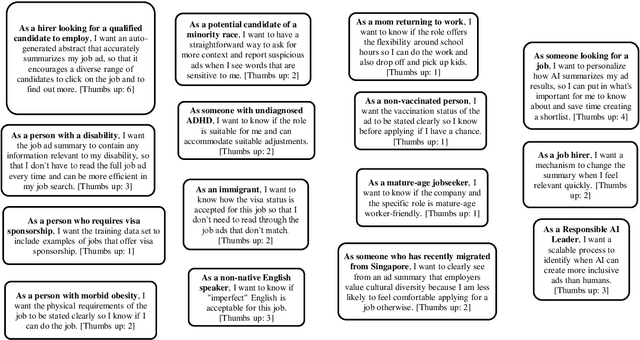
Abstract:Artificial Intelligence (AI) systems for online recruitment markets have the potential to significantly enhance the efficiency and effectiveness of job placements and even promote fairness or inclusive hiring practices. Neglecting Diversity and Inclusion (D&I) in these systems, however, can perpetuate biases, leading to unfair hiring practices and decreased workplace diversity, while exposing organisations to legal and reputational risks. Despite the acknowledged importance of D&I in AI, there is a gap in research on effectively implementing D&I guidelines in real-world recruitment systems. Challenges include a lack of awareness and framework for operationalising D&I in a cost-effective, context-sensitive manner. This study aims to investigate the practical application of D&I guidelines in AI-driven online job-seeking systems, specifically exploring how these principles can be operationalised to create more inclusive recruitment processes. We conducted a co-design workshop with a large multinational recruitment company focusing on two AI-driven recruitment use cases. User stories and personas were applied to evaluate the impacts of AI on diverse stakeholders. Follow-up interviews were conducted to assess the workshop's long-term effects on participants' awareness and application of D&I principles. The co-design workshop successfully increased participants' understanding of D&I in AI. However, translating awareness into operational practice posed challenges, particularly in balancing D&I with business goals. The results suggest developing tailored D&I guidelines and ongoing support to ensure the effective adoption of inclusive AI practices.
AI for All: Identifying AI incidents Related to Diversity and Inclusion
Jul 19, 2024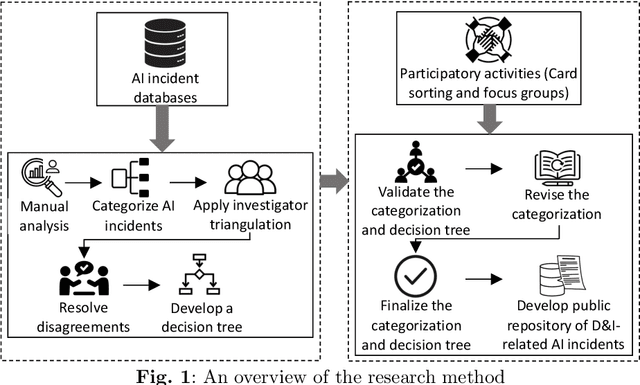

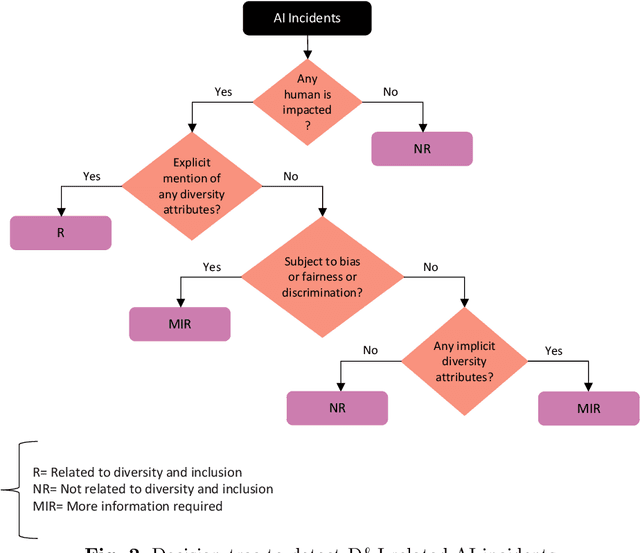

Abstract:The rapid expansion of Artificial Intelligence (AI) technologies has introduced both significant advancements and challenges, with diversity and inclusion (D&I) emerging as a critical concern. Addressing D&I in AI is essential to reduce biases and discrimination, enhance fairness, and prevent adverse societal impacts. Despite its importance, D&I considerations are often overlooked, resulting in incidents marked by built-in biases and ethical dilemmas. Analyzing AI incidents through a D&I lens is crucial for identifying causes of biases and developing strategies to mitigate them, ensuring fairer and more equitable AI technologies. However, systematic investigations of D&I-related AI incidents are scarce. This study addresses these challenges by identifying and understanding D&I issues within AI systems through a manual analysis of AI incident databases (AIID and AIAAIC). The research develops a decision tree to investigate D&I issues tied to AI incidents and populate a public repository of D&I-related AI incidents. The decision tree was validated through a card sorting exercise and focus group discussions. The research demonstrates that almost half of the analyzed AI incidents are related to D&I, with a notable predominance of racial, gender, and age discrimination. The decision tree and resulting public repository aim to foster further research and responsible AI practices, promoting the development of inclusive and equitable AI systems.
Investigating Responsible AI for Scientific Research: An Empirical Study
Dec 15, 2023Abstract:Scientific research organizations that are developing and deploying Artificial Intelligence (AI) systems are at the intersection of technological progress and ethical considerations. The push for Responsible AI (RAI) in such institutions underscores the increasing emphasis on integrating ethical considerations within AI design and development, championing core values like fairness, accountability, and transparency. For scientific research organizations, prioritizing these practices is paramount not just for mitigating biases and ensuring inclusivity, but also for fostering trust in AI systems among both users and broader stakeholders. In this paper, we explore the practices at a research organization concerning RAI practices, aiming to assess the awareness and preparedness regarding the ethical risks inherent in AI design and development. We have adopted a mixed-method research approach, utilising a comprehensive survey combined with follow-up in-depth interviews with selected participants from AI-related projects. Our results have revealed certain knowledge gaps concerning ethical, responsible, and inclusive AI, with limitations in awareness of the available AI ethics frameworks. This revealed an overarching underestimation of the ethical risks that AI technologies can present, especially when implemented without proper guidelines and governance. Our findings reveal the need for a holistic and multi-tiered strategy to uplift capabilities and better support science research teams for responsible, ethical, and inclusive AI development and deployment.
A Vision for Operationalising Diversity and Inclusion in AI
Dec 11, 2023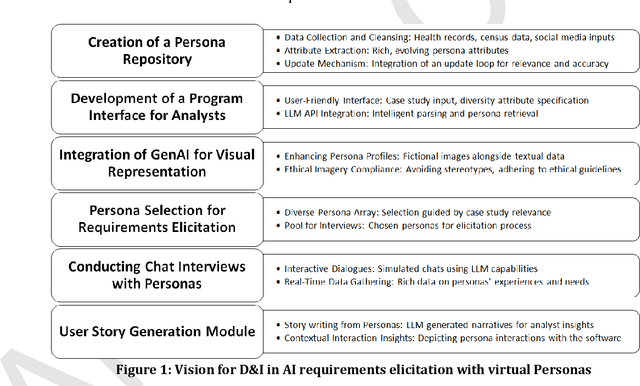
Abstract:The growing presence of Artificial Intelligence (AI) in various sectors necessitates systems that accurately reflect societal diversity. This study seeks to envision the operationalization of the ethical imperatives of diversity and inclusion (D&I) within AI ecosystems, addressing the current disconnect between ethical guidelines and their practical implementation. A significant challenge in AI development is the effective operationalization of D&I principles, which is critical to prevent the reinforcement of existing biases and ensure equity across AI applications. This paper proposes a vision of a framework for developing a tool utilizing persona-based simulation by Generative AI (GenAI). The approach aims to facilitate the representation of the needs of diverse users in the requirements analysis process for AI software. The proposed framework is expected to lead to a comprehensive persona repository with diverse attributes that inform the development process with detailed user narratives. This research contributes to the development of an inclusive AI paradigm that ensures future technological advances are designed with a commitment to the diverse fabric of humanity.
Challenges and Solutions in AI for All
Jul 20, 2023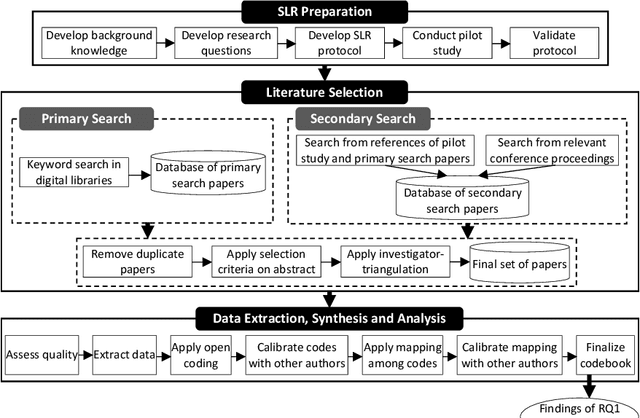
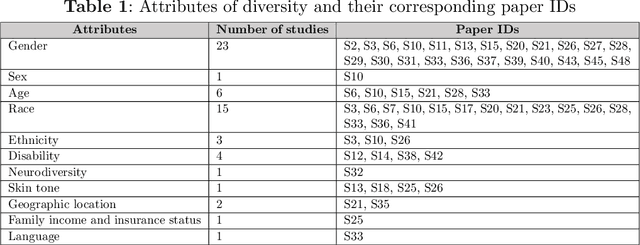
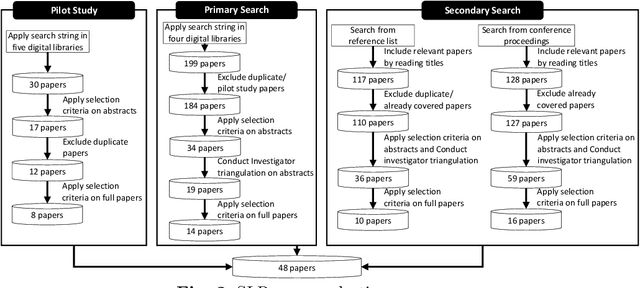
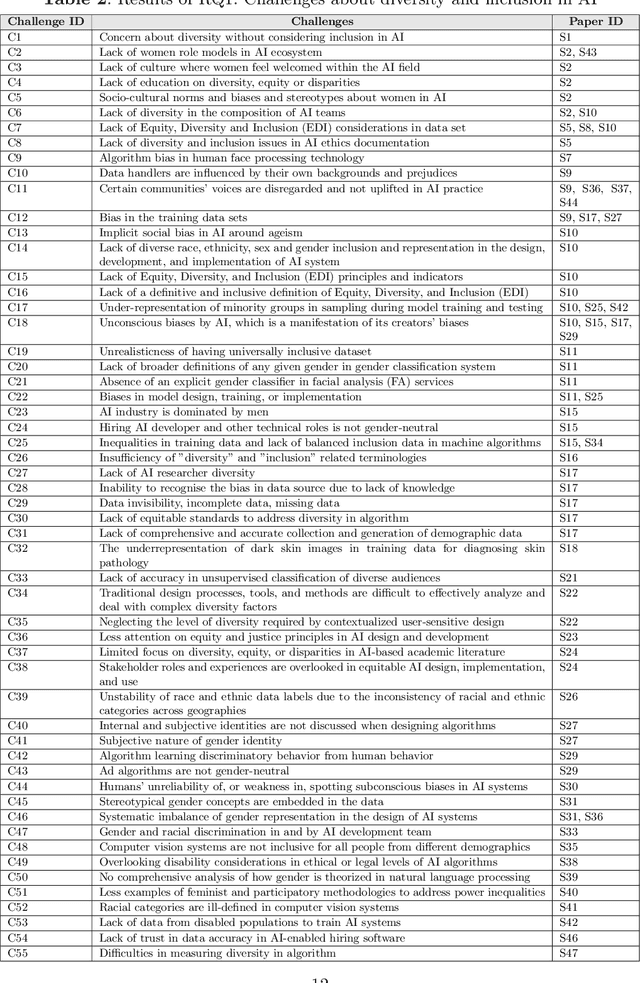
Abstract:Artificial Intelligence (AI)'s pervasive presence and variety necessitate diversity and inclusivity (D&I) principles in its design for fairness, trust, and transparency. Yet, these considerations are often overlooked, leading to issues of bias, discrimination, and perceived untrustworthiness. In response, we conducted a Systematic Review to unearth challenges and solutions relating to D&I in AI. Our rigorous search yielded 48 research articles published between 2017 and 2022. Open coding of these papers revealed 55 unique challenges and 33 solutions for D&I in AI, as well as 24 unique challenges and 23 solutions for enhancing such practices using AI. This study, by offering a deeper understanding of these issues, will enlighten researchers and practitioners seeking to integrate these principles into future AI systems.
Exploring Qualitative Research Using LLMs
Jun 23, 2023Abstract:The advent of AI driven large language models (LLMs) have stirred discussions about their role in qualitative research. Some view these as tools to enrich human understanding, while others perceive them as threats to the core values of the discipline. This study aimed to compare and contrast the comprehension capabilities of humans and LLMs. We conducted an experiment with small sample of Alexa app reviews, initially classified by a human analyst. LLMs were then asked to classify these reviews and provide the reasoning behind each classification. We compared the results with human classification and reasoning. The research indicated a significant alignment between human and ChatGPT 3.5 classifications in one third of cases, and a slightly lower alignment with GPT4 in over a quarter of cases. The two AI models showed a higher alignment, observed in more than half of the instances. However, a consensus across all three methods was seen only in about one fifth of the classifications. In the comparison of human and LLMs reasoning, it appears that human analysts lean heavily on their individual experiences. As expected, LLMs, on the other hand, base their reasoning on the specific word choices found in app reviews and the functional components of the app itself. Our results highlight the potential for effective human LLM collaboration, suggesting a synergistic rather than competitive relationship. Researchers must continuously evaluate LLMs role in their work, thereby fostering a future where AI and humans jointly enrich qualitative research.
Requirements Framework for Engineering Human-centered Artificial Intelligence-Based Software Systems
Mar 06, 2023Abstract:[Context] Artificial intelligence (AI) components used in building software solutions have substantially increased in recent years. However, many of these solutions end up focusing on technical aspects and ignore critical human-centered aspects. [Objective] Including human-centered aspects during requirements engineering (RE) when building AI-based software can help achieve more responsible, unbiased, and inclusive AI-based software solutions. [Method] In this paper, we present a new framework developed based on human-centered AI guidelines and a user survey to aid in collecting requirements for human-centered AI-based software. We provide a catalog to elicit these requirements and a conceptual model to present them visually. [Results] The framework is applied to a case study to elicit and model requirements for enhancing the quality of 360 degree~videos intended for virtual reality (VR) users. [Conclusion] We found that our proposed approach helped the project team fully understand the needs of the project to deliver. Furthermore, the framework helped to understand what requirements need to be captured at the initial stages against later stages in the engineering process of AI-based software.
 Add to Chrome
Add to Chrome Add to Firefox
Add to Firefox Add to Edge
Add to Edge